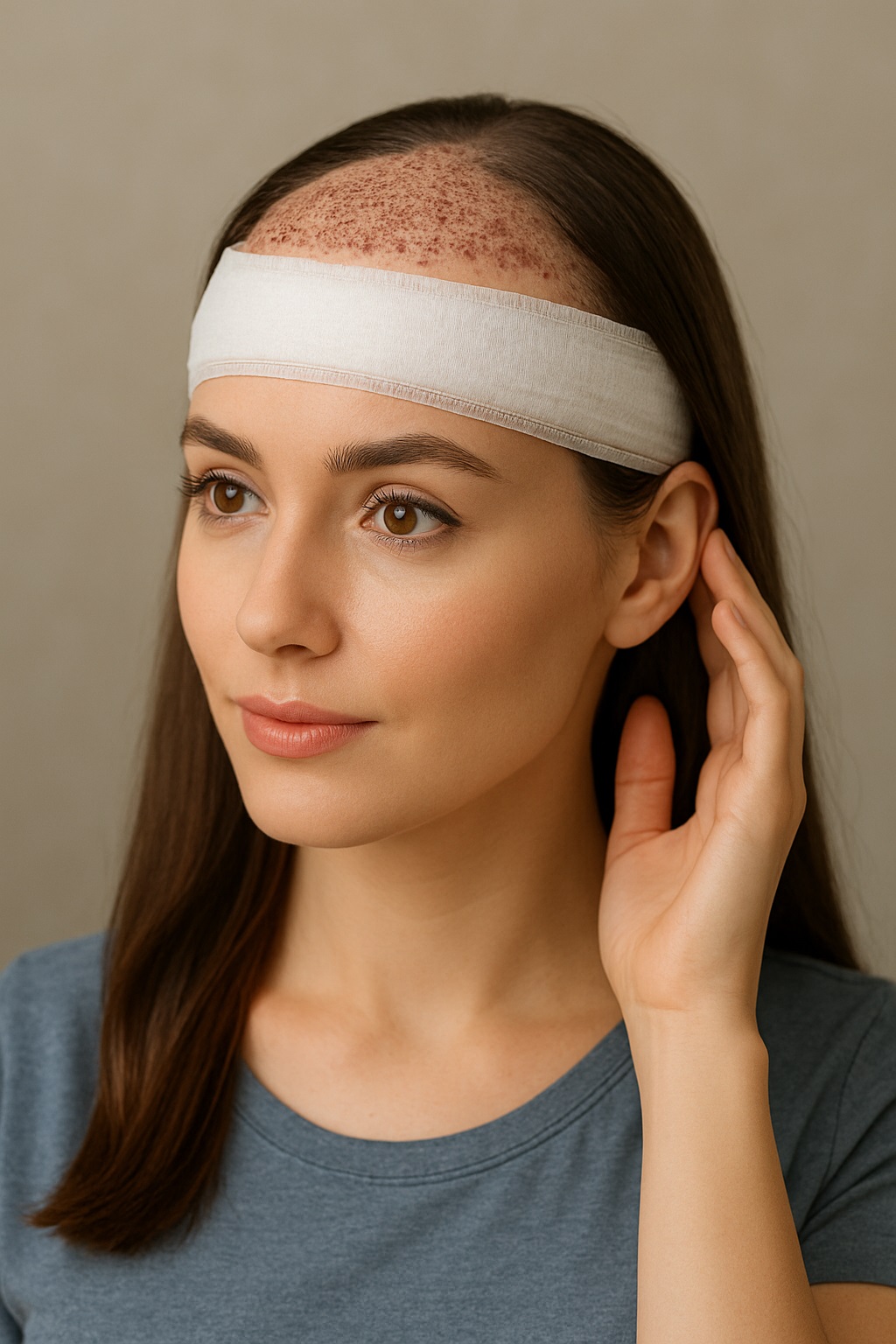At WMEDTOUR, we understand the anxiety of the “post-op” phase. Our goal is to provide clarity. We want to eliminate the guesswork. This guide explains exactly what happens beneath your scalp. We will discuss the Timeline in detail. Furthermore, we will address the psychological aspects of the healing journey. If you are still in the planning phase, you may want to visit our Skin and Hair department for more information.
📅 The Hair Transplant Recovery Timeline
The First 24 Hours: The Graft Connection
Immediately after surgery, your scalp is vulnerable. The grafts are only held by fibrin, a natural “glue.” Any friction can dislodge them. You will likely wear a bandage on the donor area. The recipient area stays exposed. You must keep it hydrated with a saline spray if provided. For medical background on tissue healing, refer to Johns Hopkins Medicine.
Days 2 to 4: The Peak of Swelling
Swelling often moves from the forehead to the eyes. This is normal. It is not an infection. It is gravity pulling the fluids down. Drinking plenty of water helps. You must avoid bending over. Use our FAQ section to learn more about managing immediate side effects.
Days 5 to 10: Scab Formation and Removal
Tiny scabs form around each graft. They might itch. You must not scratch. By day 10, these scabs should be washed away gently. Softening them with lukewarm water is key. If scabs stay too long, they may hinder oxygen flow. Many patients combine this stage with a PRP Advanced Therapy session to accelerate scalp recovery.
🚿 Essential Aftercare Tips
Proper hygiene prevents infection. It also promotes growth. Follow these steps religiously for a smooth Hair Transplant Recovery.
1. Washing Your Hair
Do not use a high-pressure shower head. Use a cup to pour water. Apply the foam or shampoo gently. Do not rub. Pat dry with a paper towel. Traditional towels can catch on grafts. For product recommendations, our Contact Us team can provide a list of approved post-op kits.
2. Sleeping Habits
Sleep on your back. Use a travel pillow. This prevents your head from turning. It ensures the recipient area does not touch the pillow. This is critical for the first week.
3. Sunlight and Sweat
Avoid direct sunlight for 3 weeks. Sunburn can damage the new follicles. Similarly, avoid heavy sweating. Sweat contains bacteria. It can lead to folliculitis. If you are recovering in a warm climate like our Oman tours, stay in air-conditioned environments.
⚖️ Pros and Cons of Early vs. Late Recovery Stages
Understanding the “Ugly Duckling” phase helps maintain your mental health. Here is a comparison of what to expect in different windows of your Timeline.
Early Stage (Weeks 1-4)
- Pro: Healing of visible wounds is very fast.
- Pro: You can see the initial “preview” of your hairline.
- Con: Shock loss (temporary shedding) begins.
- Con: Redness is most visible in this period.
Late Stage (Months 4-12)
- Pro: Real, permanent hair starts growing.
- Pro: You can style your hair and use products again.
- Con: It requires extreme patience as growth is slow.
- Con: New hairs might be thin or curly at first.
📊 Comparison Table: Activity Restrictions
| Activity Type | Restriction Period | Safety Level |
|---|---|---|
| Driving | 24 Hours | High (After sedation) |
| Walking (Light) | 2 Days | Safe |
| Sexual Activity | 7 Days | Moderate |
| Gym/Heavy Lifting | 14-21 Days | Risk to grafts |
| Swimming (Chlorine) | 30 Days | Infection risk |
👤 Who is This For?
This Guide is designed for anyone undergoing hair restoration. Whether you are a male patient treating a receding hairline or a female patient seeking density. Professionals who need to plan their leave from work will find the Timeline particularly useful. If you are an international patient, please check our All Locations page to coordinate your travel with your recovery window.
📦 The Patient Roadmap: Post-Op Edition
- Departure: Ensure you have your post-op medication. Check our medical transport options if you require assistance.
- Week 1 Home: Focus on hydration and sleep. Avoid any head trauma.
- Month 1: Transition to normal hair care. Expect shedding.
- Month 3: Begin noticing the first fine hairs emerging.
- Month 6: Significant cosmetic improvement. Visit your Doctor for a follow-up.
💼 Case Study: David’s 12-Month Journey
David, a 42-year-old manager, underwent a 4,000-graft FUE procedure. He was very concerned about the Hair Transplant Recovery. He strictly followed our Aftercare Tips.
First 2 Weeks: He worked from home. He used a spray to keep grafts moist. He avoided his usual morning run.
The 3-Month Dip: David felt discouraged when the transplanted hair fell out. We reassured him via a telemedicine consultation. This is the natural Timeline.
Final Result: By the one-year mark, David’s hairline was dense and natural. He attributed his success to the discipline he maintained during the first 14 days.
🗺️ Recovery & Tourism
Many patients choose to recover in a pleasant environment. We offer packages in India and Iran. These locations provide high-end clinics and comfortable recovery hotels. Just remember to stay away from the beach and pool for the first month. Cultural tours are fine, but keep your head protected with an umbrella or a very loose hat.
💰 Cost of Recovery Management
Aftercare often involves minor costs that you should include in your budget.
| Item | Estimated Cost (USD) | Importance |
|---|---|---|
| Post-Op Care Kit | $50 – $150 | High |
| PRP Sessions (3-set) | $300 – $800 | Optional but Recommended |
| Medications (Antibiotics/Pain) | $20 – $60 | Mandatory |
⚠️ Medical Disclaimer
Disclaimer: This content is for informational purposes only. It is not a substitute for professional medical advice. Every patient’s biology is different. Always follow the specific instructions provided by your surgeon. If you experience severe pain, bleeding, or signs of infection, contact your clinic immediately. Refer to clinical guidelines at American Academy of Dermatology.
❓ Frequently Asked Questions (FAQ)
1. Can I use a hair dryer during recovery?
No. Avoid hair dryers for at least 4 weeks. If you must, use the “cool” setting only. Heat can damage the healing scalp and the new grafts. Air drying is the safest method.
2. Is itching normal after a hair transplant?
Yes, itching is a sign of healing. However, you must never scratch. You can use a saline spray or take an antihistamine recommended by your doctor to manage the sensation.
3. When can I get a haircut?
You can cut the hair in the donor area after 2 weeks. For the transplanted area, you should wait at least 4 weeks and use scissors only. Do not use clippers on the recipient area for 6 months.
4. Can I consume alcohol after my surgery?
You should avoid alcohol for at least 5 days. Alcohol thins the blood and can lead to bleeding or increased swelling. It also interacts poorly with post-op antibiotics.
5. Why are my new hairs falling out after 3 weeks?
This is called “Shock Loss.” It is a normal part of the Timeline. The follicles enter a resting phase after the trauma of surgery. New hair will grow back in its place.
6. Can I smoke during the recovery phase?
Smoking is strongly discouraged for at least 1 month. Nicotine constricts blood vessels. This reduces oxygen flow to the scalp, which can lead to poor graft survival and slow healing.
7. How do I know if I have an infection?
Watch for extreme redness, yellow discharge (pus), or a fever. While some redness is normal, these symptoms require immediate attention. Contact our Doctors immediately if you are worried.
8. When can I wear a helmet?
You must wait at least 4 to 6 weeks before wearing a motorcycle or construction helmet. The pressure and friction can severely damage the grafts.
9. Is the first wash at the clinic mandatory?
It is highly recommended. The clinic staff knows exactly how much pressure to apply and how to soften the scabs safely. If you cannot go, follow their video instructions closely.
10. Can I sleep on my side after 10 days?
Yes, usually by day 10, the grafts are fully anchored. However, if you still have scabs or sensitivity, continuing to sleep on your back is safer.
11. Does Minoxidil help during recovery?
Many surgeons recommend restarting Minoxidil after 2-4 weeks to stimulate growth. However, do not start without your surgeon’s approval, as it can cause irritation initially.
12. When will I see the final result?
The final density and texture are usually achieved at the 12 to 15-month mark. Some patients see continued improvement up to 18 months.




